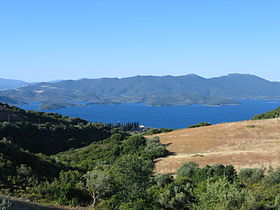Pelion
From Wikipedia, the free encyclopedia
"Pelion" and "Pilion" redirect here. For the Greek city in Chaonia, see Pellion. For the cargo ship in service 1966-67, see SS Pilion. For the town in Lexington County, South Carolina, see Pelion, South Carolina.
This article is about the mountain in Greece. For the mountain in Tasmania, see Pelion Range.
| Pelion | |
|---|---|
| Πήλιο Pilio | |
 | |
| Highest point | |
| Elevation | 1,610 m (5,280 ft) [1] |
| Prominence | 1,473 m (4,833 ft) |
| Listing | Parkland |
| Coordinates | 39.438566°N 23.046269°ECoordinates: 39.438566°N 23.046269°E |
| Naming | |
| Pronunciation | Greek: [ˈpiʎo] |
| Geography | |
| Location | eastern Magnesia, Greece |
| Parent range | Pilio |
| Geology | |
| Mountain type | Fold |
| Climbing | |
| Easiest route | road, climb |
Pelion or Pelium (Modern Greek: Πήλιο, Pílio; Ancient Greek/Katharevousa: Πήλιον. Pēlion) is a mountain at the southeastern part of Thessaly in central Greece, forming a hook-like peninsula between the Pagasetic Gulf and the Aegean Sea. Its highest summit, Pourianos Stavros, is 1,610 metres (5,280 ft) amsl.[1] The Greek National Road 38 (GR-38) runs through the southern portion of the peninsula and GR-38A runs through the middle.
Geography and economy[edit]
The mountain is thickly forested, with both deciduous and perennial forests, mainly ofbeech, oak, maple and chestnut trees, with plane tree groves surrounding places with water. Pelion is considered one of the most beautiful mountains in Greece and is a popular tourist attraction throughout the year: hiking trails and stone paths give access to springs, coves and numerous beaches, sandy or pebbly, set among lusciously green slopes. Pelion is an amply watered mountain with an abundance of springs, gorges, streams and rivulets; many streams are routed in carved-stone artificial beds to bring water to the villages and their thriving orchards. The higher elevations of the mountain receive enough snowfall so as to host skiing facilities that operate from Christmas toEaster.
Pelian cuisine specializes in charcuterie, its most famed dish being spentzofáï, a hearty stew made of sliced pork sausage that is first cooked on its own, then stewed with green and red peppers, mild or hot as the case may be, and shallots or small onions; eggplant or tomatoes are added when seasonally available. Pelion is also renowned for its orchard fruit, with pride of place going to the firíki, an originally Egyptian apple varietal of very small, oval-shaped, intensely fragrant, crisp and slightly tart apples that withstand long storage without refrigeration. There is also wide cultivation of plums, especially mirabelles and greengages.The mountain has a telecommunications tower that broadcasts radio and television including ANT1, Mega, ERT, Star Channel, Alter, TRTand more and radio including ERA, ANT1 FM and many more.
Panorama[edit]
A panorama from Pelion offers a views of the valley, the mountains of western Magnesia, Mount Olympus, the plain of Thessaly and its nearby mountains, Mavrovouni, Euboea, Central Greece and the northern Sporades islands.
Places[edit]
Modern Pelion's twenty-four villages retain traditional Pelian architecture and construction, with stone buildings made out of expertly carved local grey, blue, or green slate and red clay. They are built on terraces on the slopes and offer stunning vistas of the surrounding slopes and the sea. Houses are usually multi-storied and feature the characteristic Pelian oriel construction, with tall windows and abundant painted ornamentation. Pelian tradition calls for three-level houses, with the ground floor used for work (tools, kitchen, storage, washing, weaving), the middle floor used for socializing (common rooms), and the top floor for private rooms (bedrooms). Heat is provided by fireplaces, the chimneys of which run through the walls to provide heat to the upper levels, whereas the top level, being well ventilated, provides for summertime cooling. Interior construction is usually of chestnut timber, stained dark brown and often elaborately carved. Many of the larger Pelian mansions (the arkhontiká or "lordly mansions") have been converted into boutique hotels and hostels. The largest of all the stone buildings, which serve as points of reference for the locals, are the Pelion Towers. These are huge 300-year-old buildings with exquisite visual characteristics that combine building elements of Mountain Pelion of the 17th, 18th and 19th century. Today, Mt. Pelion is part of the Magnesia regional unit (capital city: Volos) and embraces twenty-four villages including:
Most significant:
- Agios Georgios Nileias
- Agios Lavrentios
- Argalasti
- Makrinitsa
- Milies
- Mouresi
- Portaria
- Tsangarada
- Vyzitsa
- Zagora
Others:





Δεν υπάρχουν σχόλια:
Δημοσίευση σχολίου